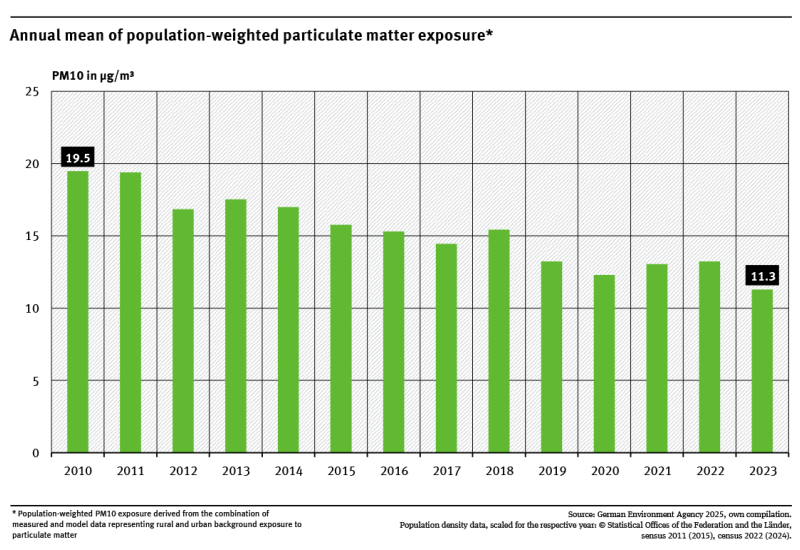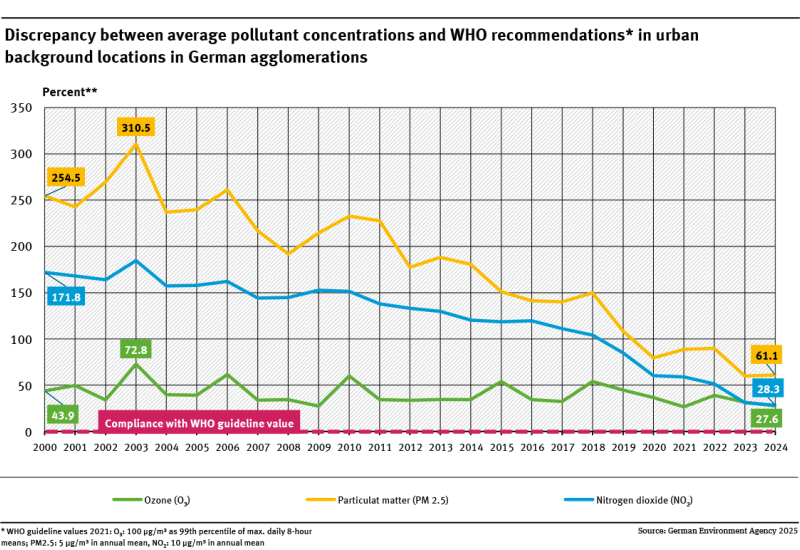Experts at the monitoring stations of the German states and the German Environment Agency take multiple daily measurements to determine the air quality in Germany. Shortly after measurements are taken, you can go to our “Current air data” webpage to look up measured values, some forecast data, and data on past years. read more
particulate matter
Air
Lead in particulate matter
Lead is a toxic heavy metal and usually occurs bound to other substances. In ambient air lead is measured bound to particulate matter. read more
Air
Cadmium in particulate matter
Cadmium is toxic and cancerogenic. It belongs to the heavy metals and usually occurs bound to other substances. In ambient air arsenic is measured bound to particulate matter. read more
Umwelt-Indikator
Indicator: Population exposure to particulate matter (PM10)
Between 2010 and 2023, the proportion of the population exposed to annual average PM10 concentrations above the WHO guideline value of 15 µg/m³ decreased from 90.5 % to 1.1 %.Since 2019, the share of the population exposed to PM10 levels above the EU limit value of 20µg/m³ (legally binding from 2030) has been below 0.5 %—and in 2023, it was 0 %.Current measures should be mainta... read more
Indicator: Population-weighted particulate matter exposure (PM10)
Population-weighted exposure to PM10 in Germany was significantly lower in 2023 than in 2010.In 2023, the population-weighted PM10 exposure was 11.3 µg/m³—approximately 42 % lower than in 2010.This decline in exposure is due to decreasing emissions from stationary sources (such as power plants, waste incineration facilities, residential heating, and industrial plants) as well as measures implement... read more
Indicator: Population exposure to particulate matter (PM2.5)
The proportion of the population exposed to annual average PM2.5 concentrations above 10 µg/m³ (the EU limit value legally binding from 2030) has decreased significantly in Germany since 2010.However, between 2010 and 2023, nearly the entire population was exposed to fine particulate matter concentrations exceeding the current WHO guideline value for PM2.5 (5 µg/m³ annual average).Therefore, furth... read more
Indicator: Population-weighted particulate matter exposure (PM2.5
Population-weighted PM2.5 exposure in Germany was significantly lower in 2023 compared to 2010.In 2023, the population-weighted annual average PM2.5 exposure level was 7.3 µg/m³—around 54 % lower than in 2010.This decline in exposure is attributable to decreasing emissions from stationary sources (such as power plants, waste incineration facilities, residential heating, and industrial plants... read more
Indicator: Air quality in agglomerations
The basic pollution levels in German conurbations significantly exceed WHO recommendations from 2021 for particulate matter (PM2.5) and nitrogen dioxide (NO₂).In the vicinity of pollutant sources, pollution levels can even be significantly higher.The situation for NO₂ and PM2.5 has improved considerably since 2000, but the WHO recommendations for 2021 are still clearly exceeded.Ozone and PM2.5 pol... read more








